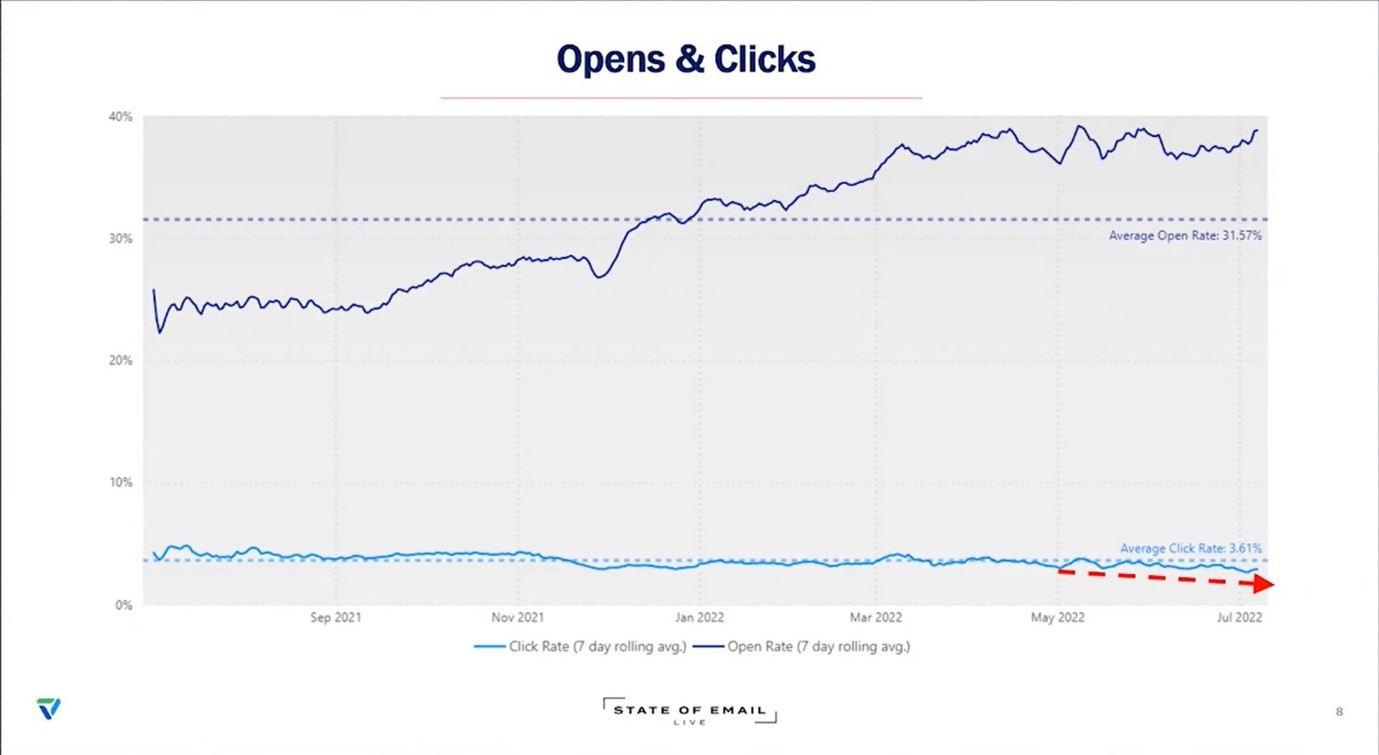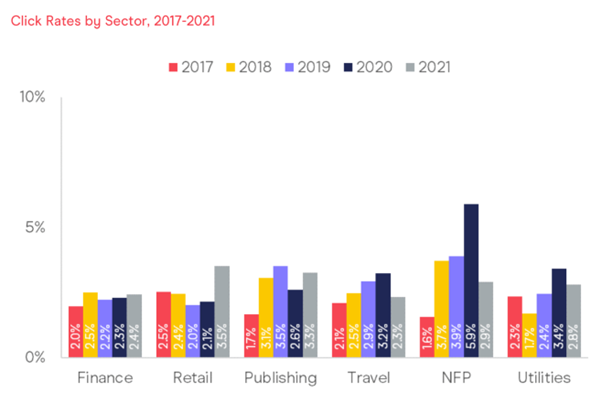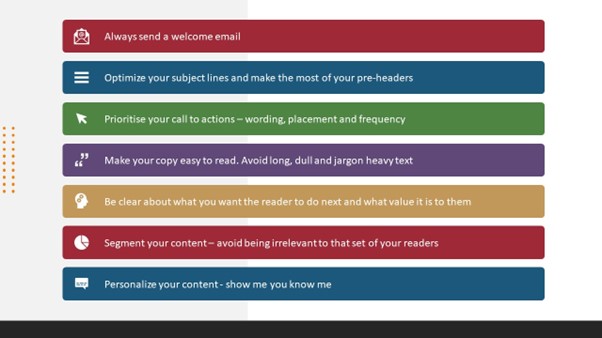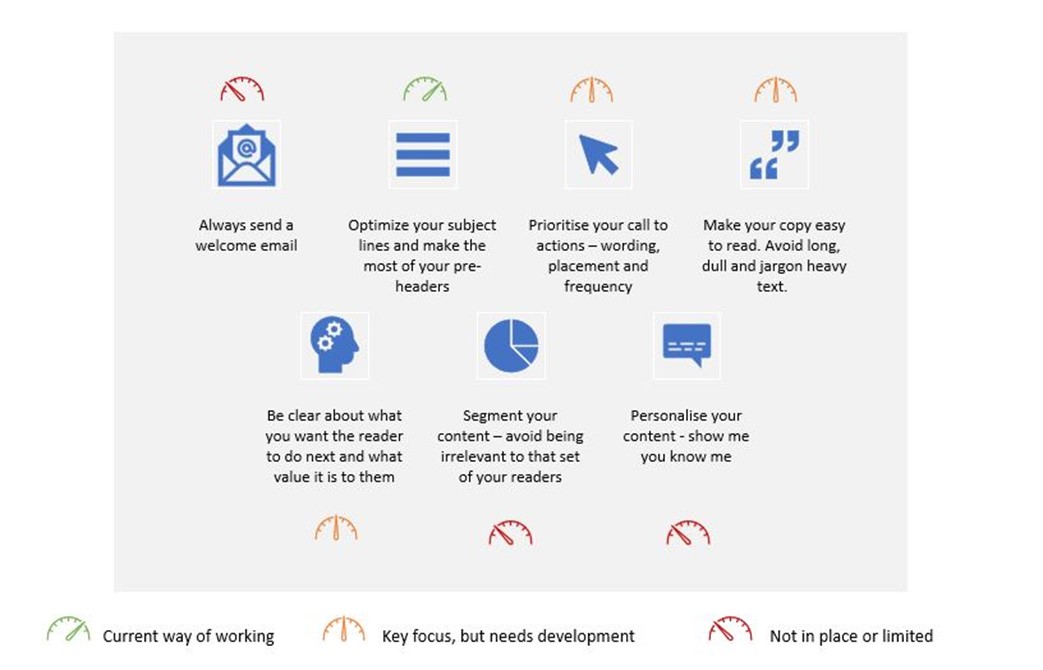Don’t optimise for the click, optimise for engagement (7 tips)
Ever thought "My click rate is decreasing, but I don’t know why." Here are some ways to further assess the situation and 7 key areas to focus on to create increased engagement (the clicks will follow.)
When reviewing your email performance are you seeing a downward trend in your click rate? As the key metric of engagement for most emails, this is a worry to any marketer. And very frustrating if there is no obvious reason from a change in approach.
This is a situation that many of my clients have found themselves in over the last few months. Here are a few reasons to consider, as well as some key areas to focus on to stop and reverse this issue.
If we can rule out obvious content, layout or core message changes, what could be causing this decline?
Has there been any changes to the send data?
For example, new or adjusted sign-up sources, changes to segmentation or a relaxation of suppression based on last open or click.
This can sometimes not be immediately apparent. One client has been (rightly) creating more targeted segments with message content tailored for that group. On review this has had the impact of leaving less engaged subscribers in the main send selection. Creating a reduced click rate. Combining main and new sends together shows that overall click has not decreased. In fact, it’s increased as the more targeted sends are creating better click rates (as you would expect with more relevant campaigns)
Has there been any external factors influencing your subscribers?
It’s prudent to look to out as well as inward when reviewing performance. PESTLE analysis is a great review framework to help with these considerations.
How might your marketing be impacted by any of these external factors:
POLITICAL
ECONOMIC
SOCIAL
TECHNOLOGICAL
LEGAL
ENVIRONMENTAL
There is currently a well-documented industry wide decline in click rate for email.
Here is a global view from data collected by Validity
(presented in their monthly State of Email series from June 22)

And from the UK’s Data and Marketing Association (DMA) 2022 Email Benchmarking report we can see that click rate decline is reported for Travel, Not for Profits, and Utilities. However not for other sectors like retail, reminding us that there is rarely a one size fits all for trends. Understanding where your business fits in the mix and any elements specific to your sector is crucial analysis.

So, do I just have to accept that click rate is declining? NO.
There are several key areas that we can all focus on to ensure a development and maturing of our email programmes. Testing and optimising individual elements of your emails should always be in place. Ensuring that current sends reach their peak of success. BUT I would also urge you to take a more engagement focussed approach to your development roadmap. Engagement will lead to improved open, click and conversion.
Seven key focus areas to increase email engagement

1. Welcome your new subscribers.
If someone has just agreed to allow you into their inbox, then make this experience shine. Don’t just drop them into your weekly newsletter or make a nod to the first time read with a one line ‘as a new subscriber…’
- Say thank you as soon as they subscribe
- Ideally provide some immediate content value based on what they were looking at (or sign-up source)
- Provide a simple way for them to find out more about your business (how easy and useful will you be to them) as part of a multi send welcome journey
2. Subject Lines (and pre-headers) make a difference
Email consumer research from the DMA asking why emails are read, confirms that brand recognition (I like emails from this company) is the primary reason for an open (55%) but subject line is a close 2nd (48%)
- It may be the last piece of content you write, but don’t make it a last-minute job
- Switch around the style; direct, entertaining, challenging etc
- Use the preheader to support the reason to open e.g., signpost other content of interest
3. Think ACTION for your ‘Call to Actions’
One of the greatest strengths of email is the ability to drive action. The words you choose for your CTA buttons and links matter. Again, don’t be lazy with these.
- Surface the value of the onward content
- Be punchy and dynamic
- Come back to your CTA and be critical ‘find out more’ and ‘click here’ do not cut it
4. Easy and simple will reduce subscriber read effort and allow your message to be absorbed.
This one is so simple that additional bullets are not required ????
5. Have one clear primary focus to your email.
- Ensure that copy and CTA and value exchange all work in harmony.
- Remove any element that might cause reader confusion
- Multiple sub-messages work, just ensure each content block promotes in its own right
6. Always try not to be irrelevant. Segment.
Lack of data or relationship history means you can’t always be relevant. Use source of sign up, content viewed or life stage to offer value where no other insight exists
- Prospects need an intro to your business and ‘help me to decide’ content
- Single purchase / user’s need ‘how to’ guides and ‘most popular’ product news
- Loyal customers know you, so what’s new? And give them a little love and thanks as well
7. Make it personal(isation)
Explicit or implicit – where you can, put the individual reader at the centre of the message. “What do you know about me and how can you use this to make me feel you care.”
Rate and assess your approach
Theory is great, but what makes the real-world difference is putting this into practice. One of the ways I suggest clients do this is to take these 7 focus areas and assess their current status based on a simple scale; ‘Current way of working’, ‘key focus, but needs development’, ‘not in place or limited’
Here’s a real-life example…

Create your action plan to increased email engagement
Reviewing your current engagement approaches based on these key 7 areas enables an action plan to be created. Consider; ease of deployment, resource and/or budget, and impact to agree priority.
Don’t panic when the clicks are down. Review your current situation in this wider context and if you don’t have all these focus areas covered, decide which one you’re going to start with. Aim for engagement and the clicks will follow.
 Photo by Marcel Eberle on Unsplash
Photo by Marcel Eberle on Unsplash

 How to resolve AdBlock issue?
How to resolve AdBlock issue? 
